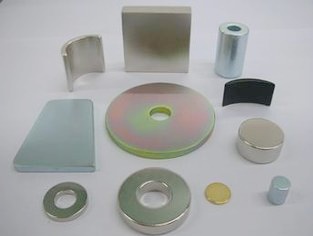Is surface treatment very important for NdFeB magnet production?
As a composition of mostly Neodymium, Iron and Boron, the iron in the neodymium magnets will get rusty if left exposed to the air. To protect the magnet from corrosion, it is better to use coated magnet.
What plating do I have for neodymium magnets?
Currently, plating of NdFeB magnet mainly includes NiCuNi coated and Zn coated. But considering the whole machine, a few products will use precious metal plating, such as alloy plating, silver or gold plating.
Nickel: nickel-plated of neodymium magnet is actually a multi-layer coating. It needs to be plated first by pre-nickel plated, then by thickened copper, then by bright nickel. Use more pyrophosphate copper to make coating thicker, but not acid copper, because the acid bath will penetrate into the pre-plating cathode nickel plating and make NdFeB substrate prone to corrosion, resulting in blistering workpiece.
Galvanization: Zn plating of NdFeB magnet uses chloride process more. Galvanized NdFeB rare earth magnet must be passivated, such as trivalent chromium and molybdate passivation. And the requirement of resistance to neutral salt spray test for color passivation is not less than 24h.
For these sintered ndfeb magnets that need other surface coating, it can be precessed after the completion of the thicker intermediate coating copper plating. Sometimes in order to increase the thickness and the reliability of the coating, it also can combine with rapid acidic copper plating process after first pyrophosphate plating to obtain a good surface decoration, and then end with other plating coatings; by this way, the results will be better.
 |
What is the difficulties of NdFeB magnet plating?
1. NdFeB magnets are mostly small parts (weight 0.25-20g), mainly coated by barrel plating, supplemented rack plating. The chemical activity of Neodymium in the magnet is very strong, and will produce hydrogen and corrode magnet if in contact with water. So before plating treatment, an acid selected should not too alkaline, otherwise material susceptible wii be corroded easily. In addition, hydrochloric acid and chlorine salt should be used with caution; do not choose a large volume of the drum, otherwise a greater impact will come out on the mixed cycle and will cause serious oxidation corrosion.
2. NdFeB magnets are the magnetic functional materials. Metal plating will be able to affect their magnetic properties. So how to coordinate the relationship between the coating type, thickness & composition and magnetic properties of the product is one of the difficulties in the NdFeB plating process.
3. Because of uncoated NdFeB magnets with porous and rough surfaces, the microscopic surface area greater than the macroscopic surface area, the requirement for pre-plating process is very high.
What is electrophoretic paint?
The most organic coating we used is oil paint. Paint is a big industry, so most of the paints can do NdFeB magnet protection. But now, more of epoxy paint is used on permanent neodymium magnet coating because of good viscidity and overall performance of the film.
There is long history for electrophoretic paint: electrophoresis and electroplate are belong to the same mode of operation, but electrophoresis has more coating methods than the electroplate; not only electrophoresis, but also spraying, brushing and the like.
The type of electrophoresis is mainly epoxy resin. In fact most of organic coatings can use electrophoretic process as magnet protection. In order to ensure the protection binding force of organic coating NdFeB, it needs basic plating, such as electro-galvanized and nickel. The worst basic coating is phosphate treatment.
Does the coating weaken the magnet?
The influence of plating on the magnetic material has two parts:
One is physical aspect, pickling electroplating process will produce corrosion on NdFeB magnet and reducing the volume will naturally affect magnetic property.
The other is nickel, nickel itself is magnetic, and will consume magnetic properties after plating.
Thus based on these two influence, there are large space to develop new technologies. Different enterprises, different NdFeB materials, different techniques, different applications and different optimizations need to be done. In addition, the new technology can reduce the damage to the magnetic properties.
A few years ago Parylene is an organic chemical vapor deposition coating, high density film and thin, but the coating is relatively soft, free of scratch proof.
Vacuum aluminum is a green protective technique; its protective performance is not less than the nickel-copper-nickel adopted now; thinner, better dimension and no influence on the magnetic properties; so it is a kind of very promising protection technology.
Is aluminum vacuum technology mature yet?
No. Vacuum aluminum is still in the trial stage, ONLY can provide sample production.
Vacuum aluminum advantage is clear: on the one hand, no reducing magnetic properties; on the one hand, it is green environmental protection. Vacuum aluminum can be realized next to production line which is benifit for enterprise management. Taking into account the environmental costs, vacuum aluminum is fully competitive compared with the nickel-copper-nickel.
 China Magnets Source Material Limited
China Magnets Source Material Limited